Taxation Law Report: Australia's Dividend Imputation System Analysis
VerifiedAdded on 2021/05/31
|14
|3517
|326
Report
AI Summary
This report offers a comprehensive analysis of Australia's dividend imputation system, exploring its core functions and historical context. It delves into the reasons behind the system's introduction, primarily to address the double taxation of corporate profits, and details how franking credits operate to offset shareholder tax liabilities. The report examines the proposed reforms by the Labour party, focusing on the removal of imputation credit refunds for individuals and superannuation funds, and discusses the potential advantages and disadvantages of these policies. It further analyzes the attributes of a good tax system, evaluating the Labour party's proposals in terms of fiscal adequacy, economic growth, and fairness. The report concludes by assessing the overall impact of these policies on various stakeholders, including investors, charities, and the broader Australian economy.
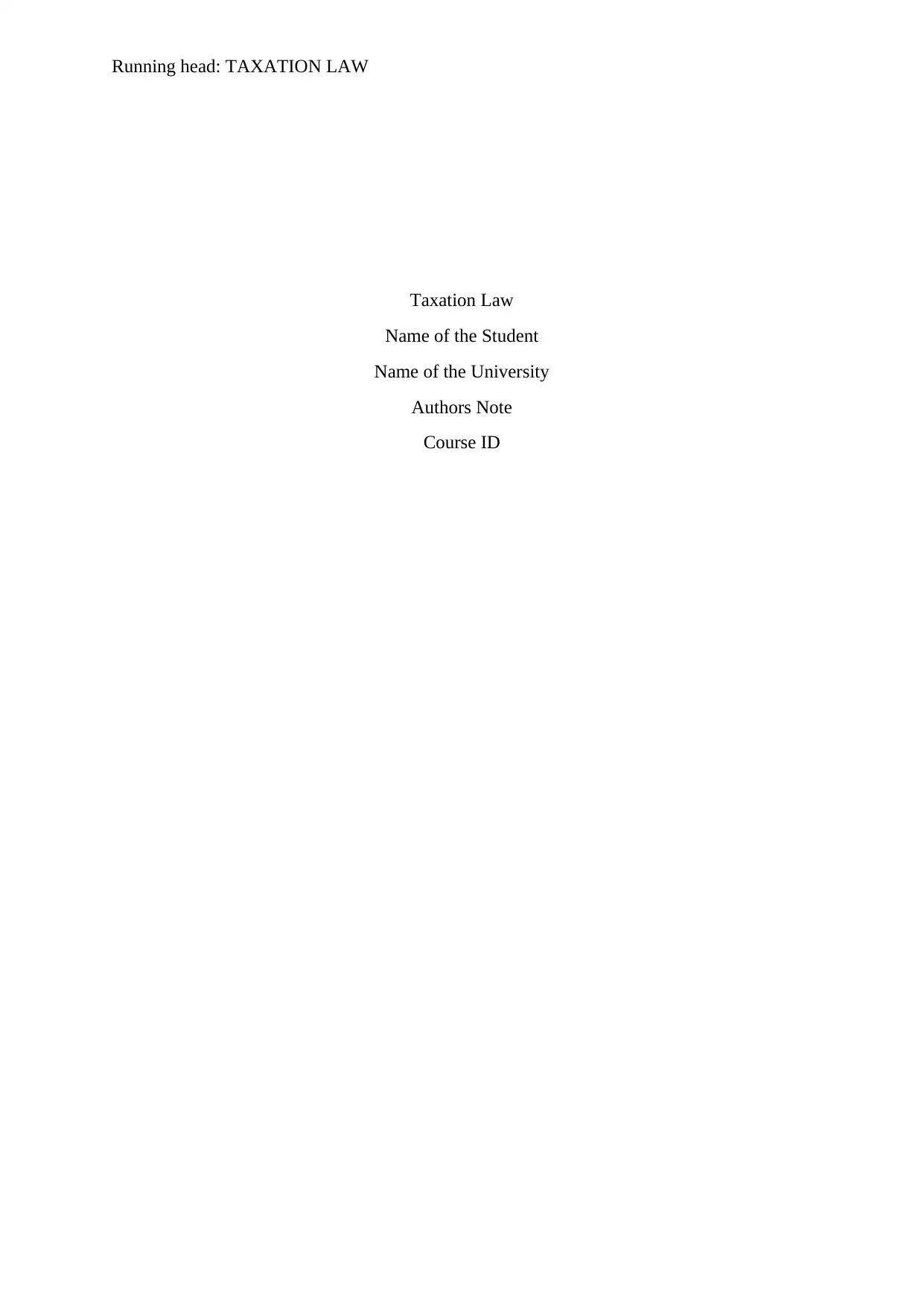
Running head: TAXATION LAW
Taxation Law
Name of the Student
Name of the University
Authors Note
Course ID
Taxation Law
Name of the Student
Name of the University
Authors Note
Course ID
Paraphrase This Document
Need a fresh take? Get an instant paraphrase of this document with our AI Paraphraser
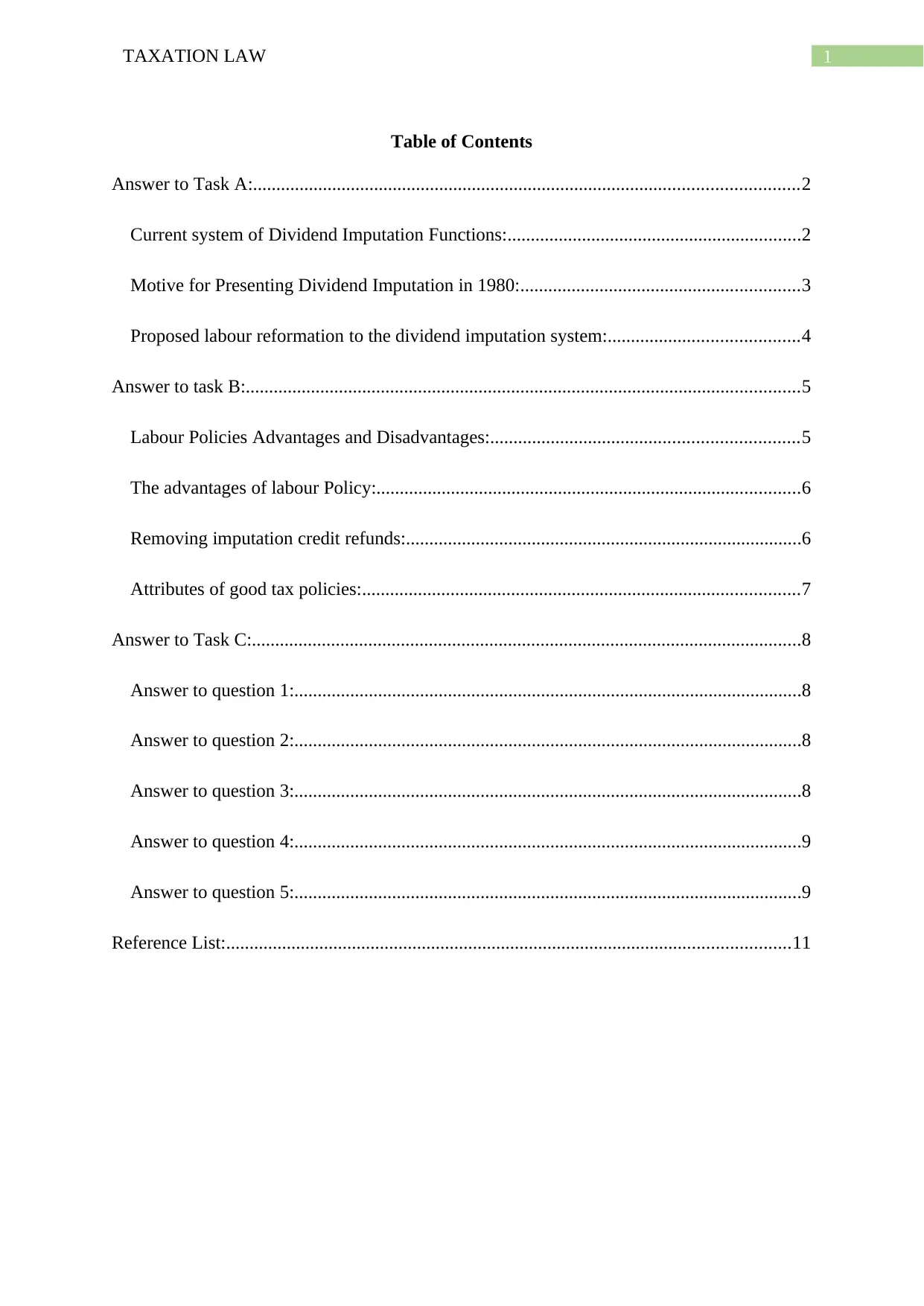
1TAXATION LAW
Table of Contents
Answer to Task A:.....................................................................................................................2
Current system of Dividend Imputation Functions:...............................................................2
Motive for Presenting Dividend Imputation in 1980:............................................................3
Proposed labour reformation to the dividend imputation system:.........................................4
Answer to task B:.......................................................................................................................5
Labour Policies Advantages and Disadvantages:..................................................................5
The advantages of labour Policy:...........................................................................................6
Removing imputation credit refunds:.....................................................................................6
Attributes of good tax policies:..............................................................................................7
Answer to Task C:......................................................................................................................8
Answer to question 1:.............................................................................................................8
Answer to question 2:.............................................................................................................8
Answer to question 3:.............................................................................................................8
Answer to question 4:.............................................................................................................9
Answer to question 5:.............................................................................................................9
Reference List:.........................................................................................................................11
Table of Contents
Answer to Task A:.....................................................................................................................2
Current system of Dividend Imputation Functions:...............................................................2
Motive for Presenting Dividend Imputation in 1980:............................................................3
Proposed labour reformation to the dividend imputation system:.........................................4
Answer to task B:.......................................................................................................................5
Labour Policies Advantages and Disadvantages:..................................................................5
The advantages of labour Policy:...........................................................................................6
Removing imputation credit refunds:.....................................................................................6
Attributes of good tax policies:..............................................................................................7
Answer to Task C:......................................................................................................................8
Answer to question 1:.............................................................................................................8
Answer to question 2:.............................................................................................................8
Answer to question 3:.............................................................................................................8
Answer to question 4:.............................................................................................................9
Answer to question 5:.............................................................................................................9
Reference List:.........................................................................................................................11
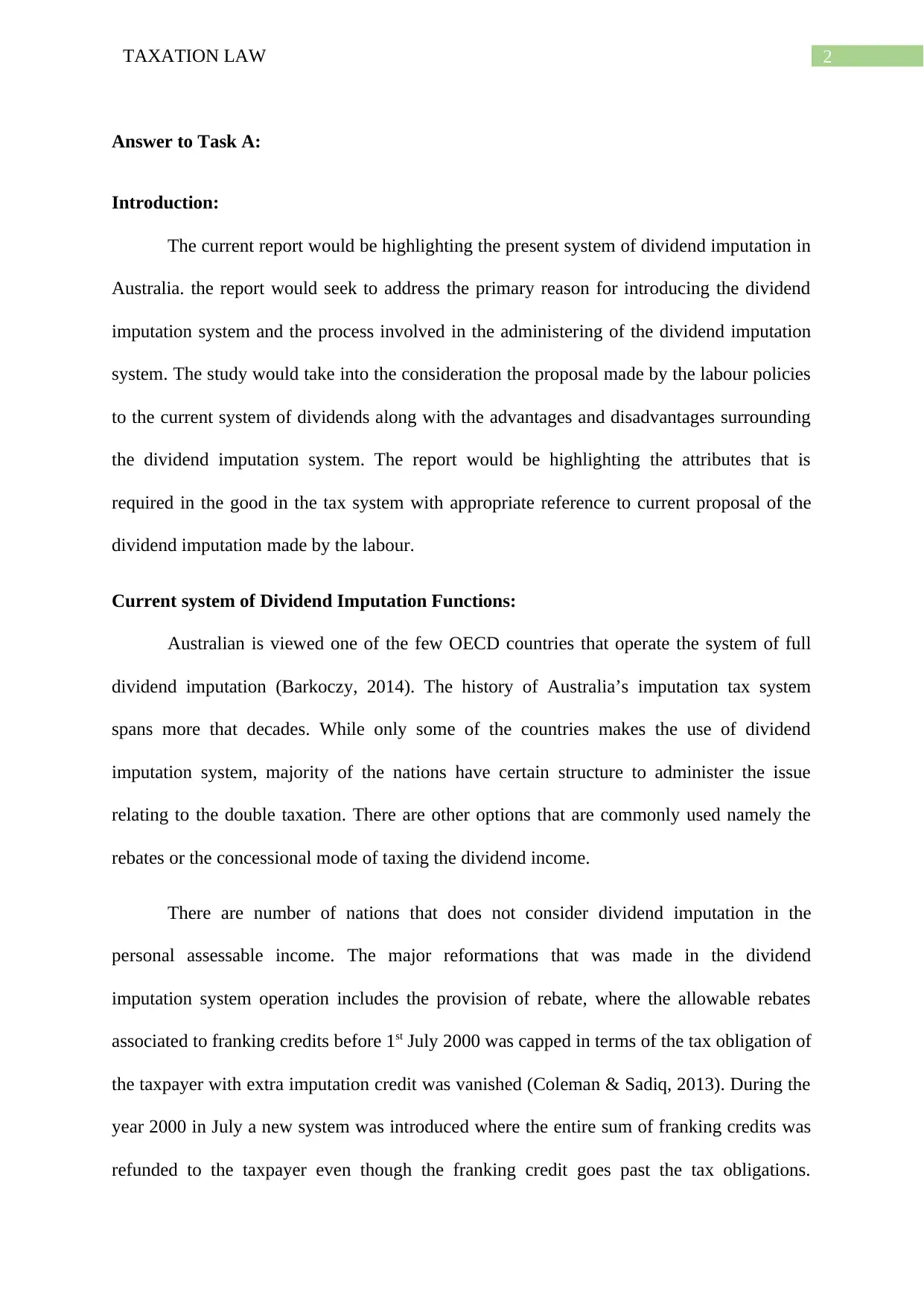
2TAXATION LAW
Answer to Task A:
Introduction:
The current report would be highlighting the present system of dividend imputation in
Australia. the report would seek to address the primary reason for introducing the dividend
imputation system and the process involved in the administering of the dividend imputation
system. The study would take into the consideration the proposal made by the labour policies
to the current system of dividends along with the advantages and disadvantages surrounding
the dividend imputation system. The report would be highlighting the attributes that is
required in the good in the tax system with appropriate reference to current proposal of the
dividend imputation made by the labour.
Current system of Dividend Imputation Functions:
Australian is viewed one of the few OECD countries that operate the system of full
dividend imputation (Barkoczy, 2014). The history of Australia’s imputation tax system
spans more that decades. While only some of the countries makes the use of dividend
imputation system, majority of the nations have certain structure to administer the issue
relating to the double taxation. There are other options that are commonly used namely the
rebates or the concessional mode of taxing the dividend income.
There are number of nations that does not consider dividend imputation in the
personal assessable income. The major reformations that was made in the dividend
imputation system operation includes the provision of rebate, where the allowable rebates
associated to franking credits before 1st July 2000 was capped in terms of the tax obligation of
the taxpayer with extra imputation credit was vanished (Coleman & Sadiq, 2013). During the
year 2000 in July a new system was introduced where the entire sum of franking credits was
refunded to the taxpayer even though the franking credit goes past the tax obligations.
Answer to Task A:
Introduction:
The current report would be highlighting the present system of dividend imputation in
Australia. the report would seek to address the primary reason for introducing the dividend
imputation system and the process involved in the administering of the dividend imputation
system. The study would take into the consideration the proposal made by the labour policies
to the current system of dividends along with the advantages and disadvantages surrounding
the dividend imputation system. The report would be highlighting the attributes that is
required in the good in the tax system with appropriate reference to current proposal of the
dividend imputation made by the labour.
Current system of Dividend Imputation Functions:
Australian is viewed one of the few OECD countries that operate the system of full
dividend imputation (Barkoczy, 2014). The history of Australia’s imputation tax system
spans more that decades. While only some of the countries makes the use of dividend
imputation system, majority of the nations have certain structure to administer the issue
relating to the double taxation. There are other options that are commonly used namely the
rebates or the concessional mode of taxing the dividend income.
There are number of nations that does not consider dividend imputation in the
personal assessable income. The major reformations that was made in the dividend
imputation system operation includes the provision of rebate, where the allowable rebates
associated to franking credits before 1st July 2000 was capped in terms of the tax obligation of
the taxpayer with extra imputation credit was vanished (Coleman & Sadiq, 2013). During the
year 2000 in July a new system was introduced where the entire sum of franking credits was
refunded to the taxpayer even though the franking credit goes past the tax obligations.
⊘ This is a preview!⊘
Do you want full access?
Subscribe today to unlock all pages.

Trusted by 1+ million students worldwide
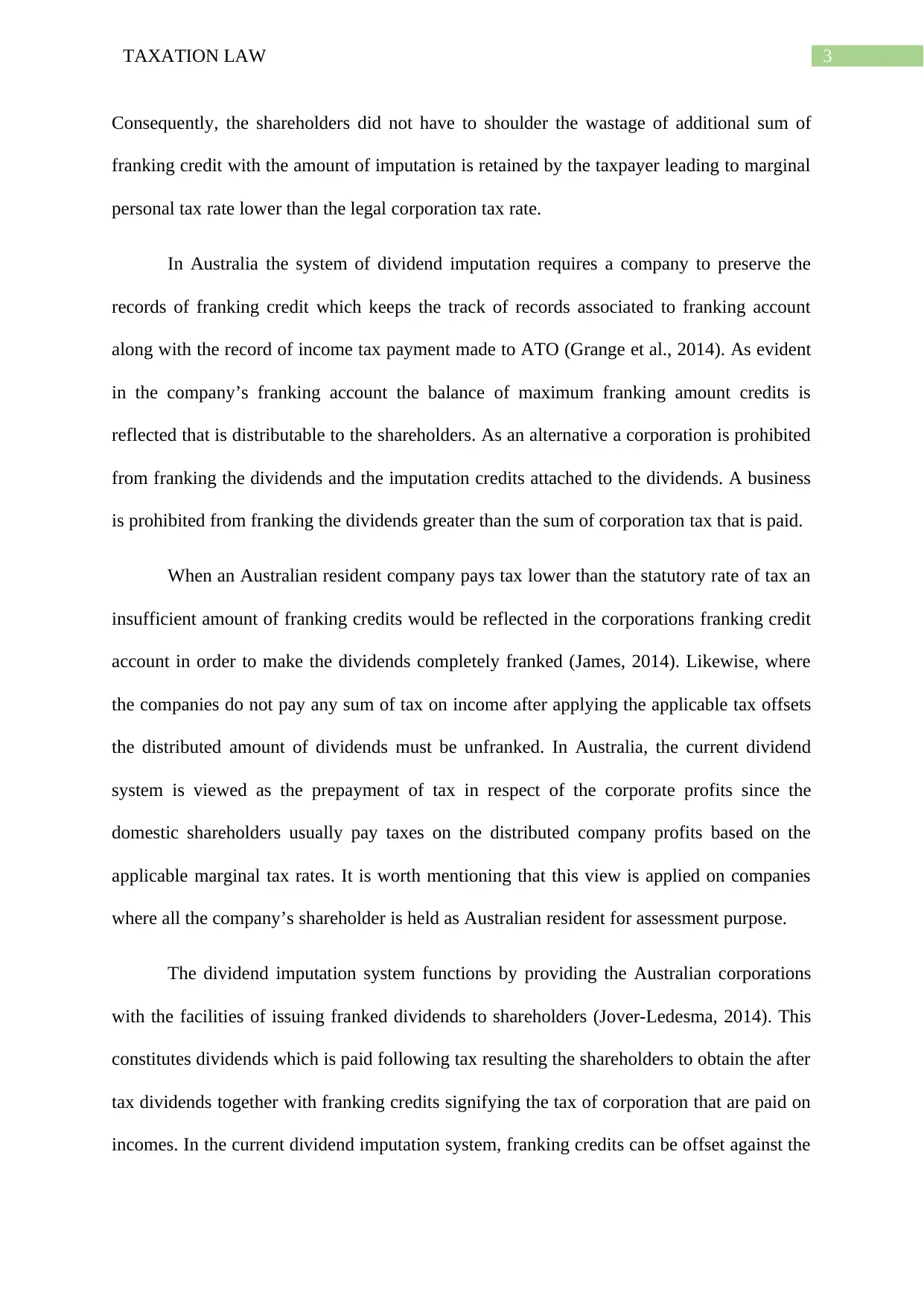
3TAXATION LAW
Consequently, the shareholders did not have to shoulder the wastage of additional sum of
franking credit with the amount of imputation is retained by the taxpayer leading to marginal
personal tax rate lower than the legal corporation tax rate.
In Australia the system of dividend imputation requires a company to preserve the
records of franking credit which keeps the track of records associated to franking account
along with the record of income tax payment made to ATO (Grange et al., 2014). As evident
in the company’s franking account the balance of maximum franking amount credits is
reflected that is distributable to the shareholders. As an alternative a corporation is prohibited
from franking the dividends and the imputation credits attached to the dividends. A business
is prohibited from franking the dividends greater than the sum of corporation tax that is paid.
When an Australian resident company pays tax lower than the statutory rate of tax an
insufficient amount of franking credits would be reflected in the corporations franking credit
account in order to make the dividends completely franked (James, 2014). Likewise, where
the companies do not pay any sum of tax on income after applying the applicable tax offsets
the distributed amount of dividends must be unfranked. In Australia, the current dividend
system is viewed as the prepayment of tax in respect of the corporate profits since the
domestic shareholders usually pay taxes on the distributed company profits based on the
applicable marginal tax rates. It is worth mentioning that this view is applied on companies
where all the company’s shareholder is held as Australian resident for assessment purpose.
The dividend imputation system functions by providing the Australian corporations
with the facilities of issuing franked dividends to shareholders (Jover-Ledesma, 2014). This
constitutes dividends which is paid following tax resulting the shareholders to obtain the after
tax dividends together with franking credits signifying the tax of corporation that are paid on
incomes. In the current dividend imputation system, franking credits can be offset against the
Consequently, the shareholders did not have to shoulder the wastage of additional sum of
franking credit with the amount of imputation is retained by the taxpayer leading to marginal
personal tax rate lower than the legal corporation tax rate.
In Australia the system of dividend imputation requires a company to preserve the
records of franking credit which keeps the track of records associated to franking account
along with the record of income tax payment made to ATO (Grange et al., 2014). As evident
in the company’s franking account the balance of maximum franking amount credits is
reflected that is distributable to the shareholders. As an alternative a corporation is prohibited
from franking the dividends and the imputation credits attached to the dividends. A business
is prohibited from franking the dividends greater than the sum of corporation tax that is paid.
When an Australian resident company pays tax lower than the statutory rate of tax an
insufficient amount of franking credits would be reflected in the corporations franking credit
account in order to make the dividends completely franked (James, 2014). Likewise, where
the companies do not pay any sum of tax on income after applying the applicable tax offsets
the distributed amount of dividends must be unfranked. In Australia, the current dividend
system is viewed as the prepayment of tax in respect of the corporate profits since the
domestic shareholders usually pay taxes on the distributed company profits based on the
applicable marginal tax rates. It is worth mentioning that this view is applied on companies
where all the company’s shareholder is held as Australian resident for assessment purpose.
The dividend imputation system functions by providing the Australian corporations
with the facilities of issuing franked dividends to shareholders (Jover-Ledesma, 2014). This
constitutes dividends which is paid following tax resulting the shareholders to obtain the after
tax dividends together with franking credits signifying the tax of corporation that are paid on
incomes. In the current dividend imputation system, franking credits can be offset against the
Paraphrase This Document
Need a fresh take? Get an instant paraphrase of this document with our AI Paraphraser
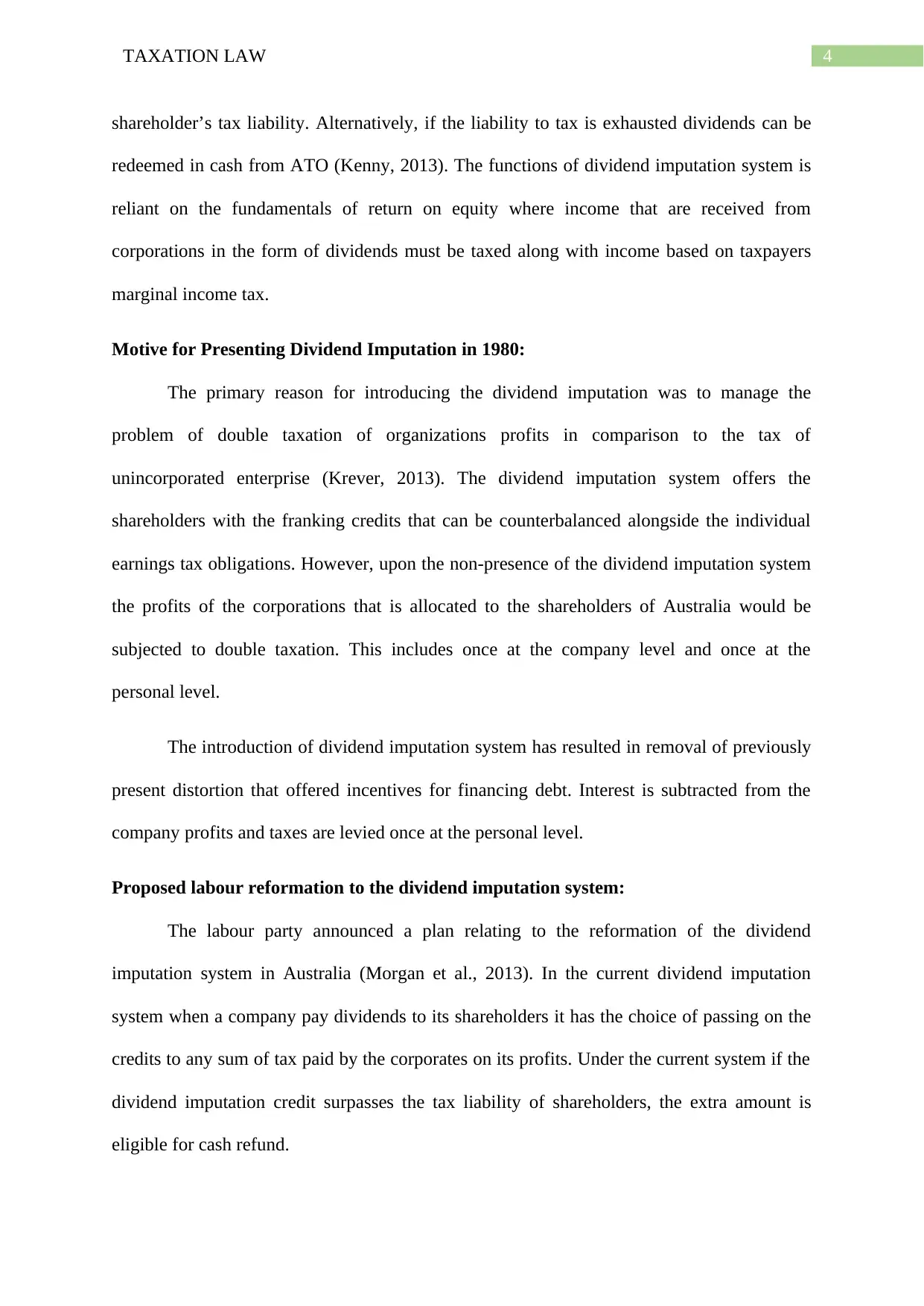
4TAXATION LAW
shareholder’s tax liability. Alternatively, if the liability to tax is exhausted dividends can be
redeemed in cash from ATO (Kenny, 2013). The functions of dividend imputation system is
reliant on the fundamentals of return on equity where income that are received from
corporations in the form of dividends must be taxed along with income based on taxpayers
marginal income tax.
Motive for Presenting Dividend Imputation in 1980:
The primary reason for introducing the dividend imputation was to manage the
problem of double taxation of organizations profits in comparison to the tax of
unincorporated enterprise (Krever, 2013). The dividend imputation system offers the
shareholders with the franking credits that can be counterbalanced alongside the individual
earnings tax obligations. However, upon the non-presence of the dividend imputation system
the profits of the corporations that is allocated to the shareholders of Australia would be
subjected to double taxation. This includes once at the company level and once at the
personal level.
The introduction of dividend imputation system has resulted in removal of previously
present distortion that offered incentives for financing debt. Interest is subtracted from the
company profits and taxes are levied once at the personal level.
Proposed labour reformation to the dividend imputation system:
The labour party announced a plan relating to the reformation of the dividend
imputation system in Australia (Morgan et al., 2013). In the current dividend imputation
system when a company pay dividends to its shareholders it has the choice of passing on the
credits to any sum of tax paid by the corporates on its profits. Under the current system if the
dividend imputation credit surpasses the tax liability of shareholders, the extra amount is
eligible for cash refund.
shareholder’s tax liability. Alternatively, if the liability to tax is exhausted dividends can be
redeemed in cash from ATO (Kenny, 2013). The functions of dividend imputation system is
reliant on the fundamentals of return on equity where income that are received from
corporations in the form of dividends must be taxed along with income based on taxpayers
marginal income tax.
Motive for Presenting Dividend Imputation in 1980:
The primary reason for introducing the dividend imputation was to manage the
problem of double taxation of organizations profits in comparison to the tax of
unincorporated enterprise (Krever, 2013). The dividend imputation system offers the
shareholders with the franking credits that can be counterbalanced alongside the individual
earnings tax obligations. However, upon the non-presence of the dividend imputation system
the profits of the corporations that is allocated to the shareholders of Australia would be
subjected to double taxation. This includes once at the company level and once at the
personal level.
The introduction of dividend imputation system has resulted in removal of previously
present distortion that offered incentives for financing debt. Interest is subtracted from the
company profits and taxes are levied once at the personal level.
Proposed labour reformation to the dividend imputation system:
The labour party announced a plan relating to the reformation of the dividend
imputation system in Australia (Morgan et al., 2013). In the current dividend imputation
system when a company pay dividends to its shareholders it has the choice of passing on the
credits to any sum of tax paid by the corporates on its profits. Under the current system if the
dividend imputation credit surpasses the tax liability of shareholders, the extra amount is
eligible for cash refund.
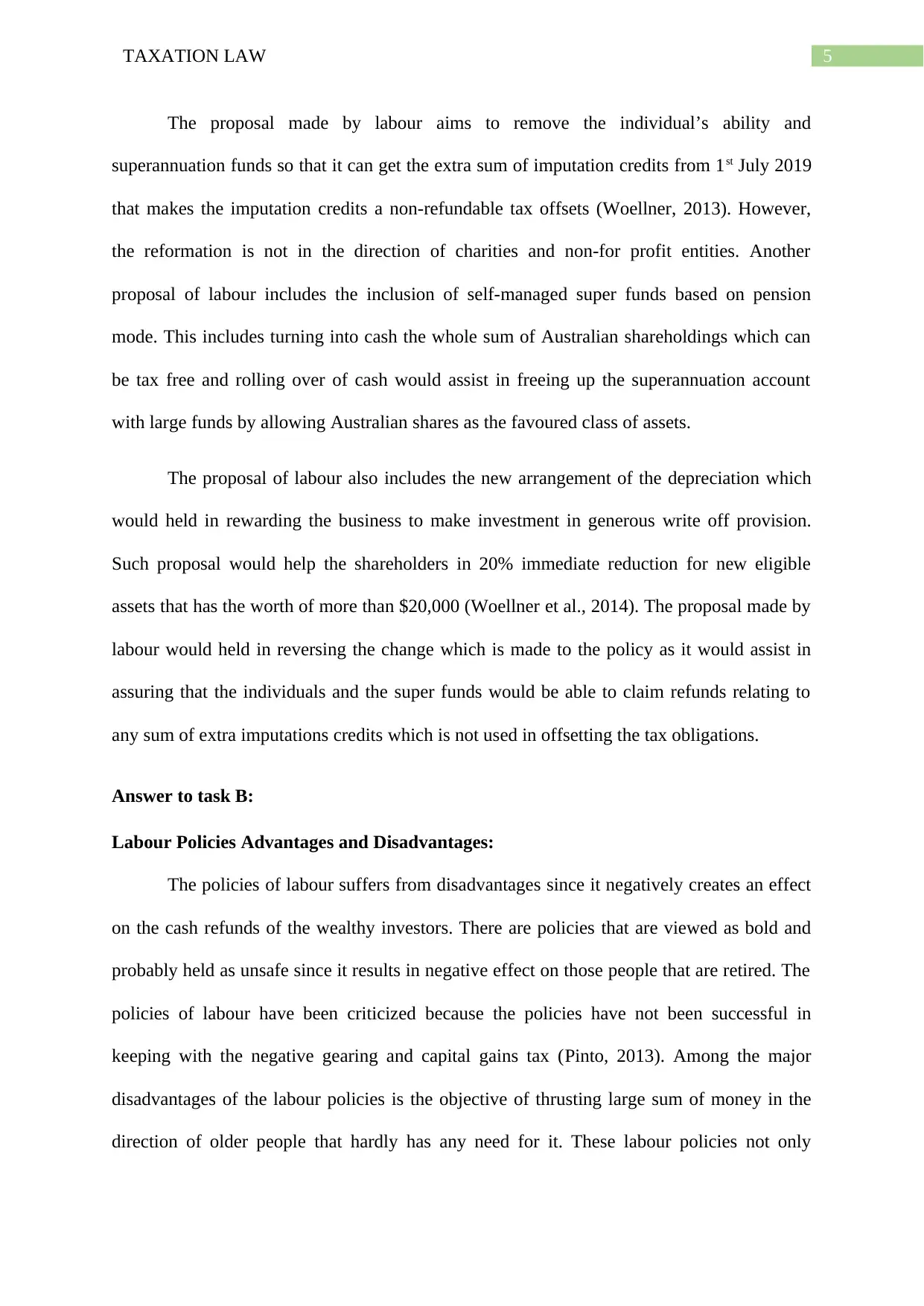
5TAXATION LAW
The proposal made by labour aims to remove the individual’s ability and
superannuation funds so that it can get the extra sum of imputation credits from 1st July 2019
that makes the imputation credits a non-refundable tax offsets (Woellner, 2013). However,
the reformation is not in the direction of charities and non-for profit entities. Another
proposal of labour includes the inclusion of self-managed super funds based on pension
mode. This includes turning into cash the whole sum of Australian shareholdings which can
be tax free and rolling over of cash would assist in freeing up the superannuation account
with large funds by allowing Australian shares as the favoured class of assets.
The proposal of labour also includes the new arrangement of the depreciation which
would held in rewarding the business to make investment in generous write off provision.
Such proposal would help the shareholders in 20% immediate reduction for new eligible
assets that has the worth of more than $20,000 (Woellner et al., 2014). The proposal made by
labour would held in reversing the change which is made to the policy as it would assist in
assuring that the individuals and the super funds would be able to claim refunds relating to
any sum of extra imputations credits which is not used in offsetting the tax obligations.
Answer to task B:
Labour Policies Advantages and Disadvantages:
The policies of labour suffers from disadvantages since it negatively creates an effect
on the cash refunds of the wealthy investors. There are policies that are viewed as bold and
probably held as unsafe since it results in negative effect on those people that are retired. The
policies of labour have been criticized because the policies have not been successful in
keeping with the negative gearing and capital gains tax (Pinto, 2013). Among the major
disadvantages of the labour policies is the objective of thrusting large sum of money in the
direction of older people that hardly has any need for it. These labour policies not only
The proposal made by labour aims to remove the individual’s ability and
superannuation funds so that it can get the extra sum of imputation credits from 1st July 2019
that makes the imputation credits a non-refundable tax offsets (Woellner, 2013). However,
the reformation is not in the direction of charities and non-for profit entities. Another
proposal of labour includes the inclusion of self-managed super funds based on pension
mode. This includes turning into cash the whole sum of Australian shareholdings which can
be tax free and rolling over of cash would assist in freeing up the superannuation account
with large funds by allowing Australian shares as the favoured class of assets.
The proposal of labour also includes the new arrangement of the depreciation which
would held in rewarding the business to make investment in generous write off provision.
Such proposal would help the shareholders in 20% immediate reduction for new eligible
assets that has the worth of more than $20,000 (Woellner et al., 2014). The proposal made by
labour would held in reversing the change which is made to the policy as it would assist in
assuring that the individuals and the super funds would be able to claim refunds relating to
any sum of extra imputations credits which is not used in offsetting the tax obligations.
Answer to task B:
Labour Policies Advantages and Disadvantages:
The policies of labour suffers from disadvantages since it negatively creates an effect
on the cash refunds of the wealthy investors. There are policies that are viewed as bold and
probably held as unsafe since it results in negative effect on those people that are retired. The
policies of labour have been criticized because the policies have not been successful in
keeping with the negative gearing and capital gains tax (Pinto, 2013). Among the major
disadvantages of the labour policies is the objective of thrusting large sum of money in the
direction of older people that hardly has any need for it. These labour policies not only
⊘ This is a preview!⊘
Do you want full access?
Subscribe today to unlock all pages.

Trusted by 1+ million students worldwide
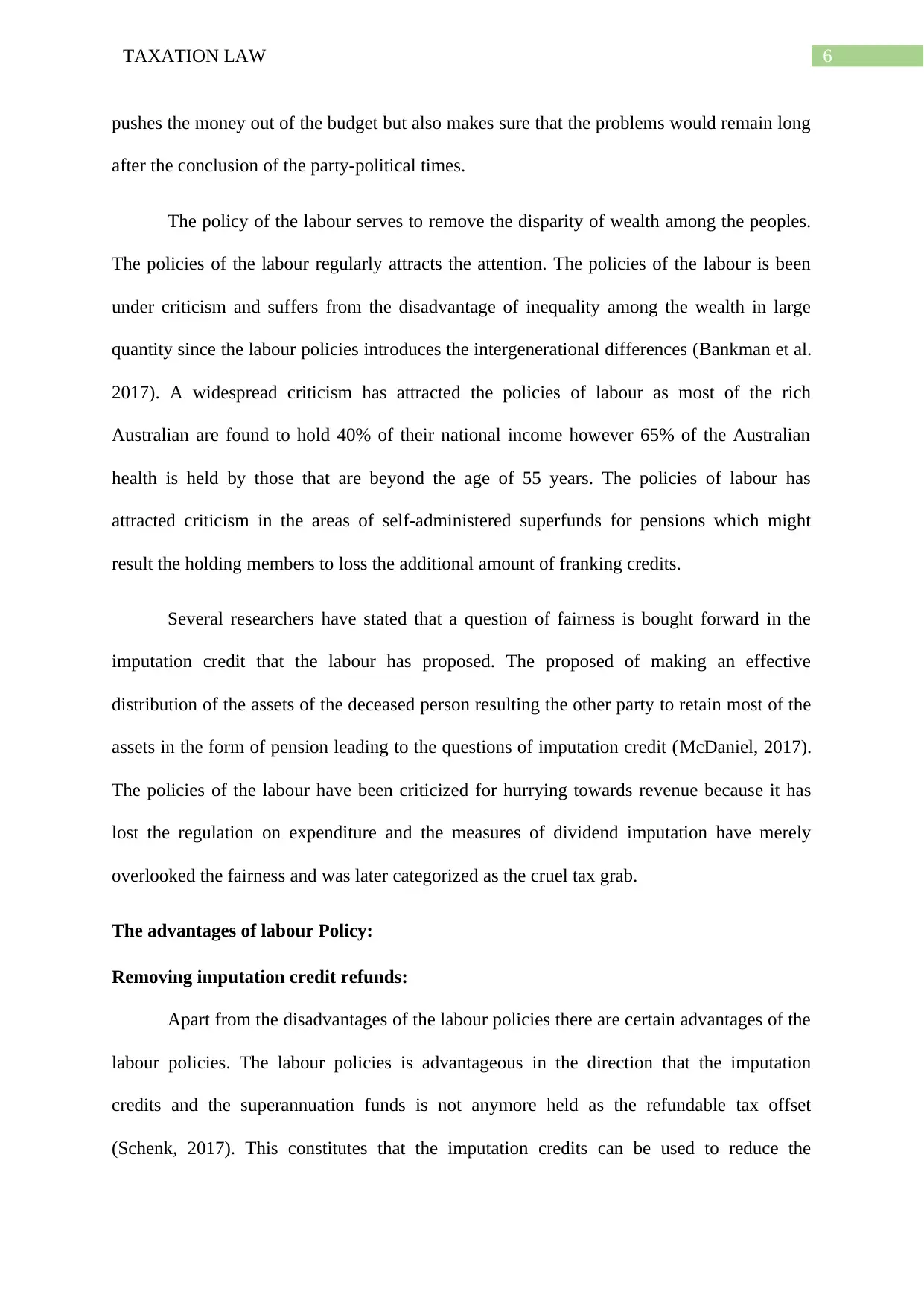
6TAXATION LAW
pushes the money out of the budget but also makes sure that the problems would remain long
after the conclusion of the party-political times.
The policy of the labour serves to remove the disparity of wealth among the peoples.
The policies of the labour regularly attracts the attention. The policies of the labour is been
under criticism and suffers from the disadvantage of inequality among the wealth in large
quantity since the labour policies introduces the intergenerational differences (Bankman et al.
2017). A widespread criticism has attracted the policies of labour as most of the rich
Australian are found to hold 40% of their national income however 65% of the Australian
health is held by those that are beyond the age of 55 years. The policies of labour has
attracted criticism in the areas of self-administered superfunds for pensions which might
result the holding members to loss the additional amount of franking credits.
Several researchers have stated that a question of fairness is bought forward in the
imputation credit that the labour has proposed. The proposed of making an effective
distribution of the assets of the deceased person resulting the other party to retain most of the
assets in the form of pension leading to the questions of imputation credit (McDaniel, 2017).
The policies of the labour have been criticized for hurrying towards revenue because it has
lost the regulation on expenditure and the measures of dividend imputation have merely
overlooked the fairness and was later categorized as the cruel tax grab.
The advantages of labour Policy:
Removing imputation credit refunds:
Apart from the disadvantages of the labour policies there are certain advantages of the
labour policies. The labour policies is advantageous in the direction that the imputation
credits and the superannuation funds is not anymore held as the refundable tax offset
(Schenk, 2017). This constitutes that the imputation credits can be used to reduce the
pushes the money out of the budget but also makes sure that the problems would remain long
after the conclusion of the party-political times.
The policy of the labour serves to remove the disparity of wealth among the peoples.
The policies of the labour regularly attracts the attention. The policies of the labour is been
under criticism and suffers from the disadvantage of inequality among the wealth in large
quantity since the labour policies introduces the intergenerational differences (Bankman et al.
2017). A widespread criticism has attracted the policies of labour as most of the rich
Australian are found to hold 40% of their national income however 65% of the Australian
health is held by those that are beyond the age of 55 years. The policies of labour has
attracted criticism in the areas of self-administered superfunds for pensions which might
result the holding members to loss the additional amount of franking credits.
Several researchers have stated that a question of fairness is bought forward in the
imputation credit that the labour has proposed. The proposed of making an effective
distribution of the assets of the deceased person resulting the other party to retain most of the
assets in the form of pension leading to the questions of imputation credit (McDaniel, 2017).
The policies of the labour have been criticized for hurrying towards revenue because it has
lost the regulation on expenditure and the measures of dividend imputation have merely
overlooked the fairness and was later categorized as the cruel tax grab.
The advantages of labour Policy:
Removing imputation credit refunds:
Apart from the disadvantages of the labour policies there are certain advantages of the
labour policies. The labour policies is advantageous in the direction that the imputation
credits and the superannuation funds is not anymore held as the refundable tax offset
(Schenk, 2017). This constitutes that the imputation credits can be used to reduce the
Paraphrase This Document
Need a fresh take? Get an instant paraphrase of this document with our AI Paraphraser
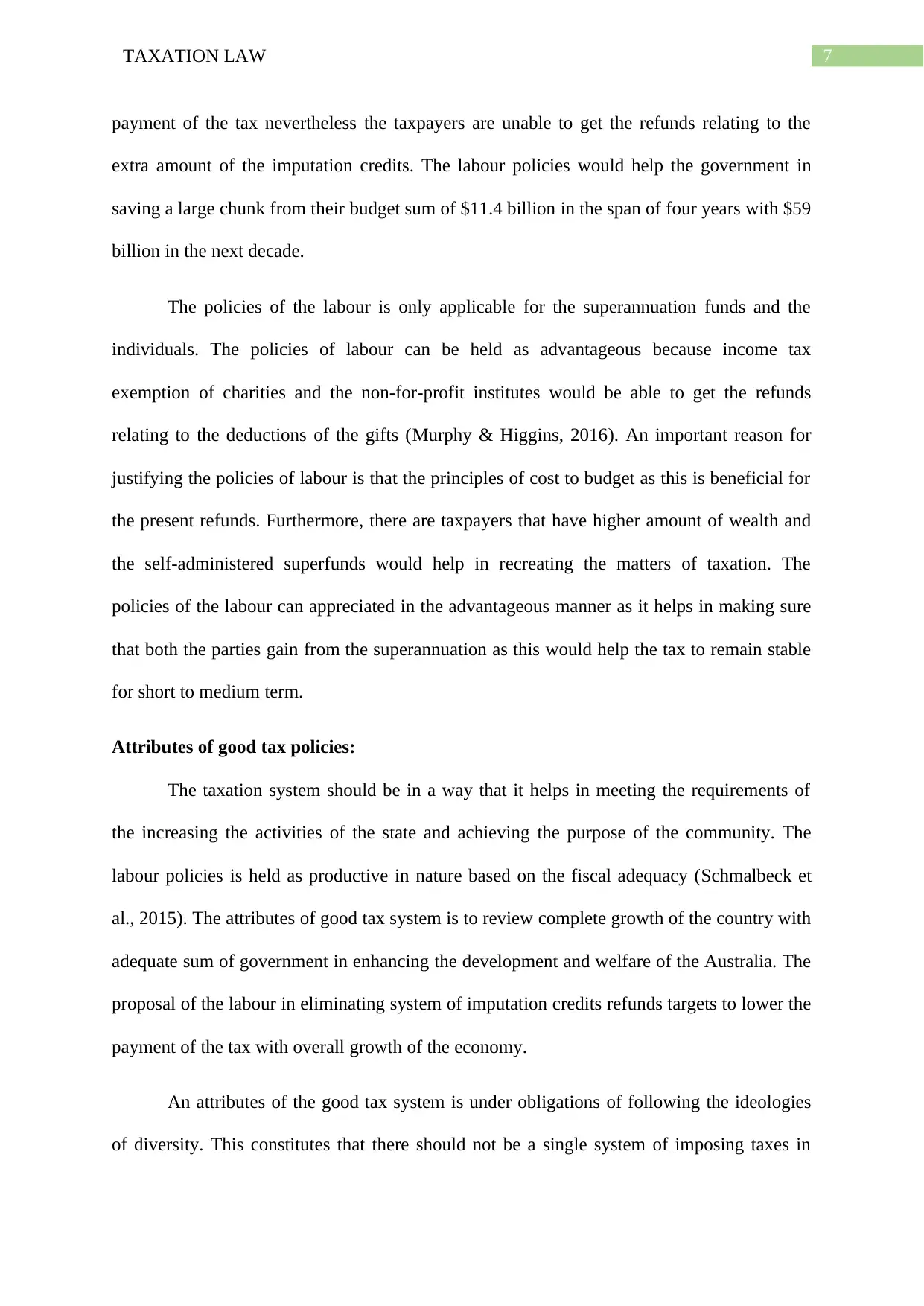
7TAXATION LAW
payment of the tax nevertheless the taxpayers are unable to get the refunds relating to the
extra amount of the imputation credits. The labour policies would help the government in
saving a large chunk from their budget sum of $11.4 billion in the span of four years with $59
billion in the next decade.
The policies of the labour is only applicable for the superannuation funds and the
individuals. The policies of labour can be held as advantageous because income tax
exemption of charities and the non-for-profit institutes would be able to get the refunds
relating to the deductions of the gifts (Murphy & Higgins, 2016). An important reason for
justifying the policies of labour is that the principles of cost to budget as this is beneficial for
the present refunds. Furthermore, there are taxpayers that have higher amount of wealth and
the self-administered superfunds would help in recreating the matters of taxation. The
policies of the labour can appreciated in the advantageous manner as it helps in making sure
that both the parties gain from the superannuation as this would help the tax to remain stable
for short to medium term.
Attributes of good tax policies:
The taxation system should be in a way that it helps in meeting the requirements of
the increasing the activities of the state and achieving the purpose of the community. The
labour policies is held as productive in nature based on the fiscal adequacy (Schmalbeck et
al., 2015). The attributes of good tax system is to review complete growth of the country with
adequate sum of government in enhancing the development and welfare of the Australia. The
proposal of the labour in eliminating system of imputation credits refunds targets to lower the
payment of the tax with overall growth of the economy.
An attributes of the good tax system is under obligations of following the ideologies
of diversity. This constitutes that there should not be a single system of imposing taxes in
payment of the tax nevertheless the taxpayers are unable to get the refunds relating to the
extra amount of the imputation credits. The labour policies would help the government in
saving a large chunk from their budget sum of $11.4 billion in the span of four years with $59
billion in the next decade.
The policies of the labour is only applicable for the superannuation funds and the
individuals. The policies of labour can be held as advantageous because income tax
exemption of charities and the non-for-profit institutes would be able to get the refunds
relating to the deductions of the gifts (Murphy & Higgins, 2016). An important reason for
justifying the policies of labour is that the principles of cost to budget as this is beneficial for
the present refunds. Furthermore, there are taxpayers that have higher amount of wealth and
the self-administered superfunds would help in recreating the matters of taxation. The
policies of the labour can appreciated in the advantageous manner as it helps in making sure
that both the parties gain from the superannuation as this would help the tax to remain stable
for short to medium term.
Attributes of good tax policies:
The taxation system should be in a way that it helps in meeting the requirements of
the increasing the activities of the state and achieving the purpose of the community. The
labour policies is held as productive in nature based on the fiscal adequacy (Schmalbeck et
al., 2015). The attributes of good tax system is to review complete growth of the country with
adequate sum of government in enhancing the development and welfare of the Australia. The
proposal of the labour in eliminating system of imputation credits refunds targets to lower the
payment of the tax with overall growth of the economy.
An attributes of the good tax system is under obligations of following the ideologies
of diversity. This constitutes that there should not be a single system of imposing taxes in
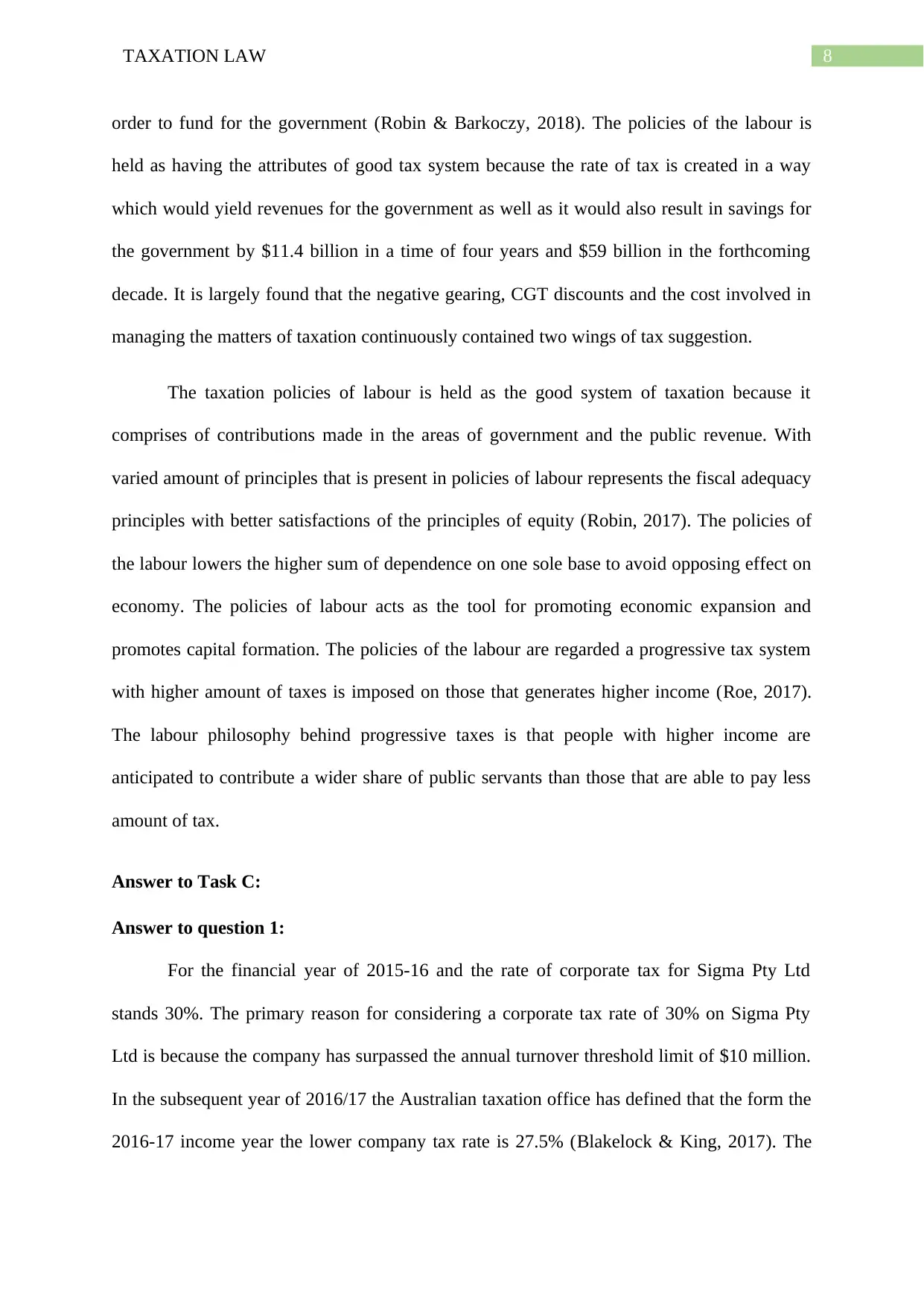
8TAXATION LAW
order to fund for the government (Robin & Barkoczy, 2018). The policies of the labour is
held as having the attributes of good tax system because the rate of tax is created in a way
which would yield revenues for the government as well as it would also result in savings for
the government by $11.4 billion in a time of four years and $59 billion in the forthcoming
decade. It is largely found that the negative gearing, CGT discounts and the cost involved in
managing the matters of taxation continuously contained two wings of tax suggestion.
The taxation policies of labour is held as the good system of taxation because it
comprises of contributions made in the areas of government and the public revenue. With
varied amount of principles that is present in policies of labour represents the fiscal adequacy
principles with better satisfactions of the principles of equity (Robin, 2017). The policies of
the labour lowers the higher sum of dependence on one sole base to avoid opposing effect on
economy. The policies of labour acts as the tool for promoting economic expansion and
promotes capital formation. The policies of the labour are regarded a progressive tax system
with higher amount of taxes is imposed on those that generates higher income (Roe, 2017).
The labour philosophy behind progressive taxes is that people with higher income are
anticipated to contribute a wider share of public servants than those that are able to pay less
amount of tax.
Answer to Task C:
Answer to question 1:
For the financial year of 2015-16 and the rate of corporate tax for Sigma Pty Ltd
stands 30%. The primary reason for considering a corporate tax rate of 30% on Sigma Pty
Ltd is because the company has surpassed the annual turnover threshold limit of $10 million.
In the subsequent year of 2016/17 the Australian taxation office has defined that the form the
2016-17 income year the lower company tax rate is 27.5% (Blakelock & King, 2017). The
order to fund for the government (Robin & Barkoczy, 2018). The policies of the labour is
held as having the attributes of good tax system because the rate of tax is created in a way
which would yield revenues for the government as well as it would also result in savings for
the government by $11.4 billion in a time of four years and $59 billion in the forthcoming
decade. It is largely found that the negative gearing, CGT discounts and the cost involved in
managing the matters of taxation continuously contained two wings of tax suggestion.
The taxation policies of labour is held as the good system of taxation because it
comprises of contributions made in the areas of government and the public revenue. With
varied amount of principles that is present in policies of labour represents the fiscal adequacy
principles with better satisfactions of the principles of equity (Robin, 2017). The policies of
the labour lowers the higher sum of dependence on one sole base to avoid opposing effect on
economy. The policies of labour acts as the tool for promoting economic expansion and
promotes capital formation. The policies of the labour are regarded a progressive tax system
with higher amount of taxes is imposed on those that generates higher income (Roe, 2017).
The labour philosophy behind progressive taxes is that people with higher income are
anticipated to contribute a wider share of public servants than those that are able to pay less
amount of tax.
Answer to Task C:
Answer to question 1:
For the financial year of 2015-16 and the rate of corporate tax for Sigma Pty Ltd
stands 30%. The primary reason for considering a corporate tax rate of 30% on Sigma Pty
Ltd is because the company has surpassed the annual turnover threshold limit of $10 million.
In the subsequent year of 2016/17 the Australian taxation office has defined that the form the
2016-17 income year the lower company tax rate is 27.5% (Blakelock & King, 2017). The
⊘ This is a preview!⊘
Do you want full access?
Subscribe today to unlock all pages.

Trusted by 1+ million students worldwide
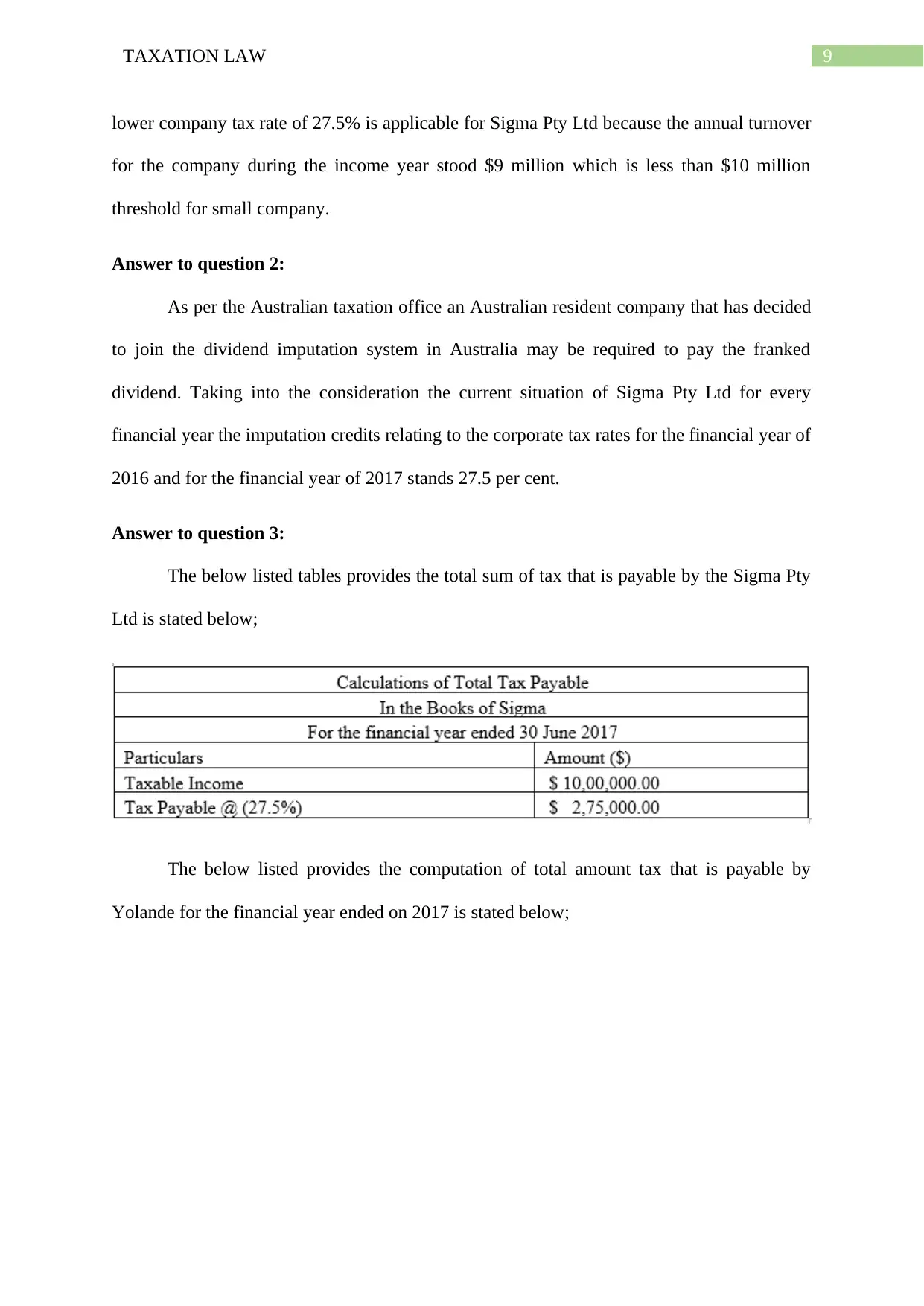
9TAXATION LAW
lower company tax rate of 27.5% is applicable for Sigma Pty Ltd because the annual turnover
for the company during the income year stood $9 million which is less than $10 million
threshold for small company.
Answer to question 2:
As per the Australian taxation office an Australian resident company that has decided
to join the dividend imputation system in Australia may be required to pay the franked
dividend. Taking into the consideration the current situation of Sigma Pty Ltd for every
financial year the imputation credits relating to the corporate tax rates for the financial year of
2016 and for the financial year of 2017 stands 27.5 per cent.
Answer to question 3:
The below listed tables provides the total sum of tax that is payable by the Sigma Pty
Ltd is stated below;
The below listed provides the computation of total amount tax that is payable by
Yolande for the financial year ended on 2017 is stated below;
lower company tax rate of 27.5% is applicable for Sigma Pty Ltd because the annual turnover
for the company during the income year stood $9 million which is less than $10 million
threshold for small company.
Answer to question 2:
As per the Australian taxation office an Australian resident company that has decided
to join the dividend imputation system in Australia may be required to pay the franked
dividend. Taking into the consideration the current situation of Sigma Pty Ltd for every
financial year the imputation credits relating to the corporate tax rates for the financial year of
2016 and for the financial year of 2017 stands 27.5 per cent.
Answer to question 3:
The below listed tables provides the total sum of tax that is payable by the Sigma Pty
Ltd is stated below;
The below listed provides the computation of total amount tax that is payable by
Yolande for the financial year ended on 2017 is stated below;
Paraphrase This Document
Need a fresh take? Get an instant paraphrase of this document with our AI Paraphraser

10TAXATION LAW
Answer to question 4:
Based on the tax rate the answer is “No”. The primary reason is that the answer would
not be held different given the purchase of shares were made by the Yolande during the 30th
May 2017. Another important factor involved in the static tax rate is because the tax rate
based on the imputation would remain to 27.5 and the same is applied in case of both the
Sigma Pty Ltd and for Yolande as well. The rate of corporate tax during the financial year
ended 2016-17 stands 27.5 for the Sigma Pty Ltd this is because the annual turnover limit of
the company stood less than the small company turnover threshold limit of $10 million.
Answer to question 5:
The rate of corporate tax for Sigma Pty Ltd and for Yolade would remain different.
The reason for this is that the aggregate sum of the total turnover threshold have gone past the
$10 million limit and this results in different amount of tax payment for both the Yolande and
the Sigma Pty Ltd during the year 2016-17. A tabular representation of the total amount of
tax that is payable for both is stated below;
Table representing Computation of Tax Payable by the Sigma Pty Ltd is stated below;
Answer to question 4:
Based on the tax rate the answer is “No”. The primary reason is that the answer would
not be held different given the purchase of shares were made by the Yolande during the 30th
May 2017. Another important factor involved in the static tax rate is because the tax rate
based on the imputation would remain to 27.5 and the same is applied in case of both the
Sigma Pty Ltd and for Yolande as well. The rate of corporate tax during the financial year
ended 2016-17 stands 27.5 for the Sigma Pty Ltd this is because the annual turnover limit of
the company stood less than the small company turnover threshold limit of $10 million.
Answer to question 5:
The rate of corporate tax for Sigma Pty Ltd and for Yolade would remain different.
The reason for this is that the aggregate sum of the total turnover threshold have gone past the
$10 million limit and this results in different amount of tax payment for both the Yolande and
the Sigma Pty Ltd during the year 2016-17. A tabular representation of the total amount of
tax that is payable for both is stated below;
Table representing Computation of Tax Payable by the Sigma Pty Ltd is stated below;
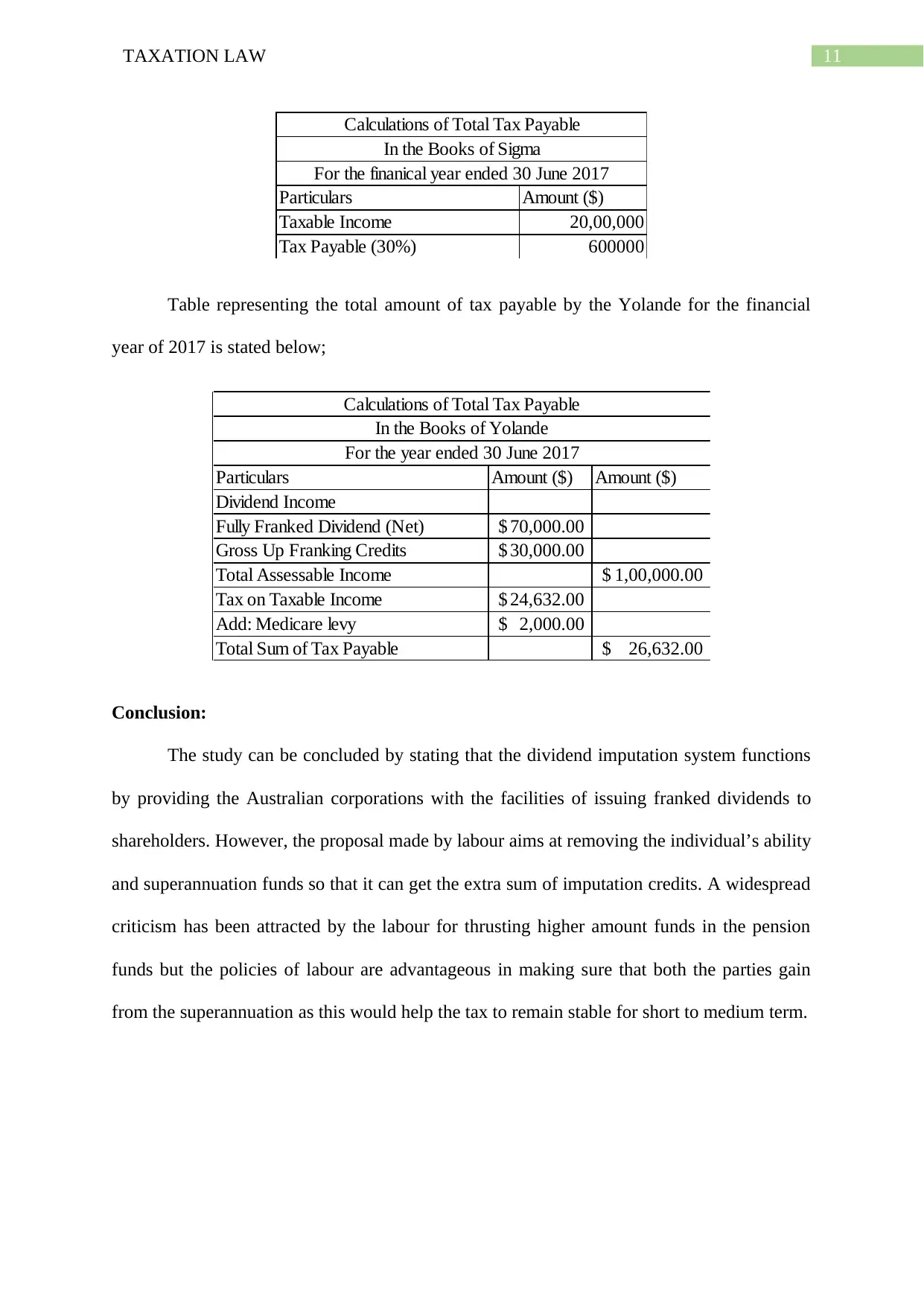
11TAXATION LAW
Particulars Amount ($)
Taxable Income 20,00,000
Tax Payable (30%) 600000
Calculations of Total Tax Payable
In the Books of Sigma
For the finanical year ended 30 June 2017
Table representing the total amount of tax payable by the Yolande for the financial
year of 2017 is stated below;
Particulars Amount ($) Amount ($)
Dividend Income
Fully Franked Dividend (Net) 70,000.00$
Gross Up Franking Credits 30,000.00$
Total Assessable Income 1,00,000.00$
Tax on Taxable Income 24,632.00$
Add: Medicare levy 2,000.00$
Total Sum of Tax Payable 26,632.00$
For the year ended 30 June 2017
Calculations of Total Tax Payable
In the Books of Yolande
Conclusion:
The study can be concluded by stating that the dividend imputation system functions
by providing the Australian corporations with the facilities of issuing franked dividends to
shareholders. However, the proposal made by labour aims at removing the individual’s ability
and superannuation funds so that it can get the extra sum of imputation credits. A widespread
criticism has been attracted by the labour for thrusting higher amount funds in the pension
funds but the policies of labour are advantageous in making sure that both the parties gain
from the superannuation as this would help the tax to remain stable for short to medium term.
Particulars Amount ($)
Taxable Income 20,00,000
Tax Payable (30%) 600000
Calculations of Total Tax Payable
In the Books of Sigma
For the finanical year ended 30 June 2017
Table representing the total amount of tax payable by the Yolande for the financial
year of 2017 is stated below;
Particulars Amount ($) Amount ($)
Dividend Income
Fully Franked Dividend (Net) 70,000.00$
Gross Up Franking Credits 30,000.00$
Total Assessable Income 1,00,000.00$
Tax on Taxable Income 24,632.00$
Add: Medicare levy 2,000.00$
Total Sum of Tax Payable 26,632.00$
For the year ended 30 June 2017
Calculations of Total Tax Payable
In the Books of Yolande
Conclusion:
The study can be concluded by stating that the dividend imputation system functions
by providing the Australian corporations with the facilities of issuing franked dividends to
shareholders. However, the proposal made by labour aims at removing the individual’s ability
and superannuation funds so that it can get the extra sum of imputation credits. A widespread
criticism has been attracted by the labour for thrusting higher amount funds in the pension
funds but the policies of labour are advantageous in making sure that both the parties gain
from the superannuation as this would help the tax to remain stable for short to medium term.
⊘ This is a preview!⊘
Do you want full access?
Subscribe today to unlock all pages.

Trusted by 1+ million students worldwide
1 out of 14
Related Documents
Your All-in-One AI-Powered Toolkit for Academic Success.
+13062052269
info@desklib.com
Available 24*7 on WhatsApp / Email
![[object Object]](/_next/static/media/star-bottom.7253800d.svg)
Unlock your academic potential
Copyright © 2020–2025 A2Z Services. All Rights Reserved. Developed and managed by ZUCOL.





